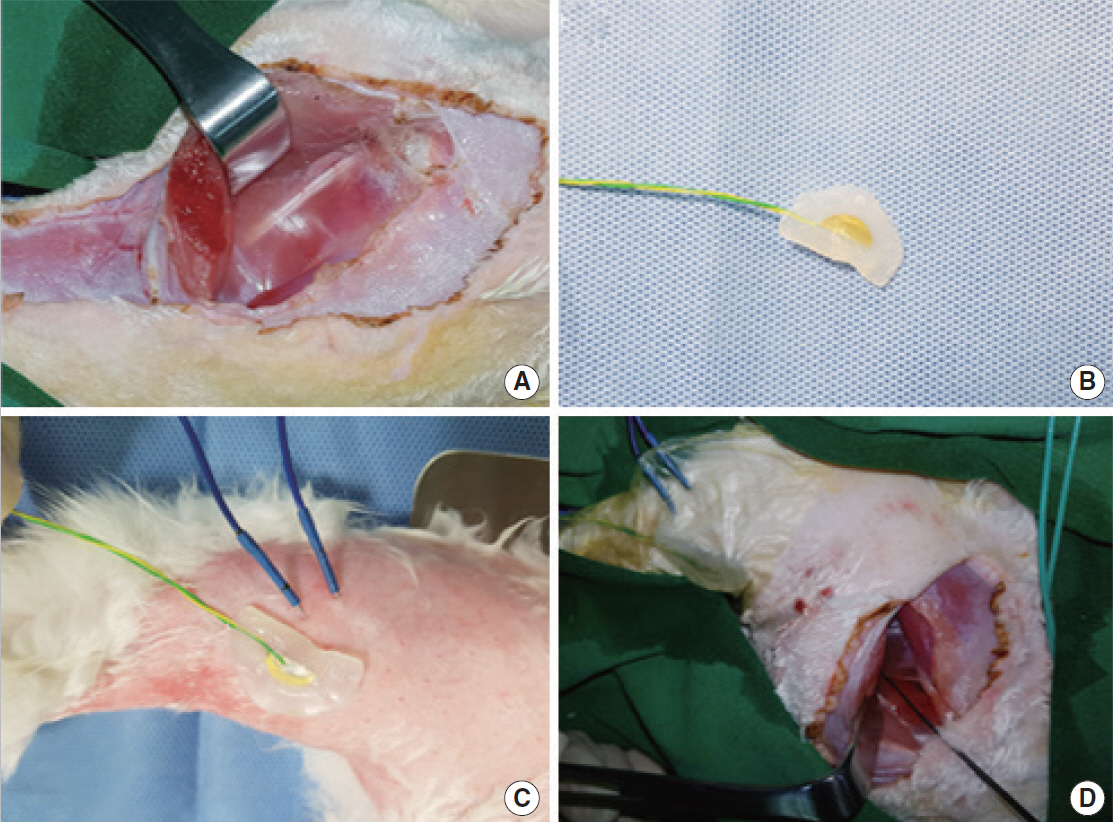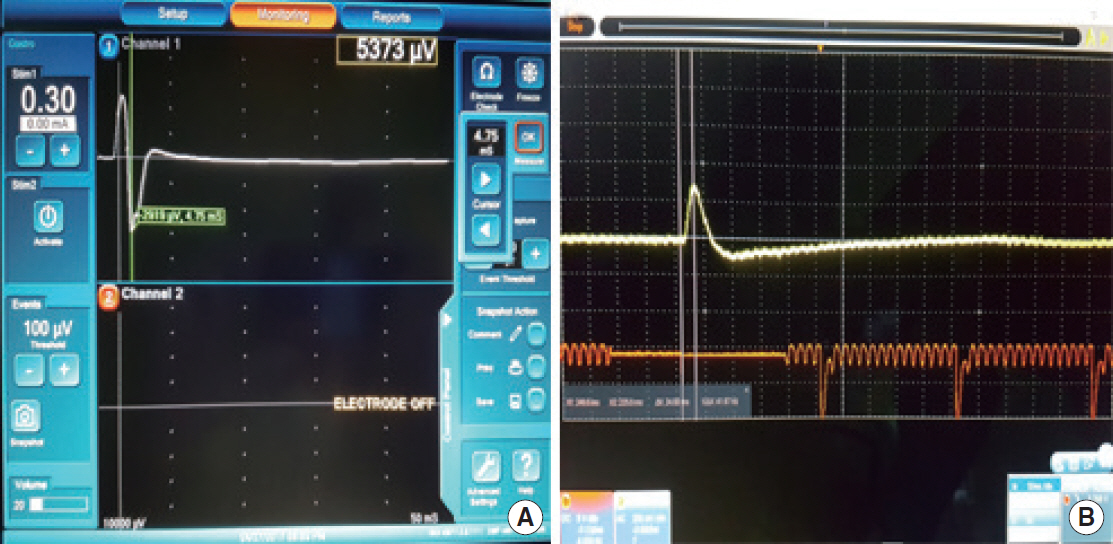Development of a Novel Intraoperative Neuromonitoring System Using a Surface Pressure Sensor to Detect Muscle Movement: A Rabbit Model Study
- Affiliations
-
- 1Department of Otolaryngology, Head and Neck Surgery and Research Institute for Convergence of Biomedical Science and Technology, Pusan National University College of Medicine, Yangsan, Korea.
- 2Department of Otolaryngology, Head and Neck Surgery and Medical Research Institute, Pusan National University College of Medicine, Busan, Korea. voiceleebj@gmail.com
- 3Department of Biomedical Engineering, Pusan National University Hospital, Busan, Korea.
- KMID: 2447432
- DOI: http://doi.org/10.21053/ceo.2018.01207
Abstract
OBJECTIVES
False-negative or false-positive responses in intraoperative neuromonitoring (IONM) using electromyography (EMG) in thyroid surgery pose a challenge. Therefore, we developed a novel IONM system that uses a surface pressure sensor instead of EMG to detect muscle twitching. This study aimed to investigate the feasibility and safety of a new IONM system using a piezo-electric surface pressure sensor in an experimental animal model.
METHODS
We developed the surface pressure sensor by modifying a commercial piezo-electric sensor. We evaluated the stimulus thresholds to detect muscle movement, as well as the amplitude and latency of the EMG and surface pressure sensor in six sciatic nerves of three rabbits, according to the stimulus intensity.
RESULTS
The surface pressure sensor detected the muscle movements in response to a 0.1 mA stimulation of all six sciatic nerves. There were no differences in the thresholds of stimulus intensity between the surface pressure sensor and EMG recordings to detect muscle movements.
CONCLUSION
It is possible to measure the change in surface pressure by using a piezo-electric surface pressure sensor instead of EMG to detect muscle movement induced by nerve stimulation. The application of IONM using a piezo-electric surface pressure sensor during surgery is noninvasive, safe, and feasible. Measuring muscle twitching to identify the state of the nerves using the novel IONM system can be an alternative to recording of EMG responses.
Keyword
MeSH Terms
Figure
Cited by 5 articles
-
Development of a Novel Intraoperative Neuromonitoring System Using an Accelerometer Sensor in Thyroid Surgery: A Porcine Model Study
Eui-Suk Sung, Jin-Choon Lee, Sung-Chan Shin, Hyun-Keun Kwon, Han-Seul Na, Da-Hee Park, Seong-Wook Choi, Jung-Hoon Ro, Byung-Joo Lee
Clin Exp Otorhinolaryngol. 2019;12(4):420-426. doi: 10.21053/ceo.2019.00423.Application of an Intraoperative Neuromonitoring System Using a Surface Pressure Sensor in Parotid Surgery: A Rabbit Model Study
Eui-Suk Sung, Hyun-Keun Kwon, Sung-Chan Shin, Young-Il Cheon, Jung-Woo Lee, Da-Hee Park, Seong-Wook Choi, Hwa-Bin Kim, Hye-Jin Park, Jin-Choon Lee, Jung-Hoon Ro, Byung-Joo Lee
Clin Exp Otorhinolaryngol. 2021;14(1):131-136. doi: 10.21053/ceo.2019.01900.A New Era of Intraoperative Neuromonitoring: Beyond the Electromyography Endotracheal Tube During Thyroid Surgery
Sung-Chan Shin, Byung-Joo Lee
Clin Exp Otorhinolaryngol. 2020;13(4):324-325. doi: 10.21053/ceo.2020.01158.Application of Novel Intraoperative Neuromonitoring System Using an Endotracheal Tube With Pressure Sensor During Thyroid Surgery: A Porcine Model Study
Eui-Suk Sung, Sung-Chan Shin, Hyun-Keun Kwon, Jia Kim, Da-Hee Park, Seong-Wook Choi, Sang-Hoon Kim, Jin-Choon Lee, Jung-Hoon Ro, Byung-Joo Lee
Clin Exp Otorhinolaryngol. 2020;13(3):291-298. doi: 10.21053/ceo.2019.01249.Intraoperative Neuromonitoring System Using Needle and Skin Electrode during Thyroid Surgery
Sung-Chan Shin, Myeonggu Seo, Yong-Il Cheon, Byung-Joo Lee
Int J Thyroidol. 2022;15(1):17-22. doi: 10.11106/ijt.2022.15.1.17.
Reference
-
1. Jeannon JP, Orabi AA, Bruch GA, Abdalsalam HA, Simo R. Diagnosis of recurrent laryngeal nerve palsy after thyroidectomy: a systematic review. Int J Clin Pract. 2009; Apr. 63(4):624–9.
Article2. Lo CY, Kwok KF, Yuen PW. A prospective evaluation of recurrent laryngeal nerve paralysis during thyroidectomy. Arch Surg. 2000; Feb. 135(2):204–7.
Article3. Chiang FY, Lu IC, Kuo WR, Lee KW, Chang NC, Wu CW. The mechanism of recurrent laryngeal nerve injury during thyroid surgery: the application of intraoperative neuromonitoring. Surgery. 2008; Jun. 143(6):743–9.4. Dionigi G, Alesina PF, Barczynski M, Boni L, Chiang FY, Kim HY, et al. Recurrent laryngeal nerve injury in video-assisted thyroidectomy: lessons learned from neuromonitoring. Surg Endosc. 2012; Sep. 26(9):2601–8.
Article5. Randolph GW, Dralle H; International Intraoperative Monitoring Study Group, Abdullah H, Barczynski M, Bellantone R, et al. Electrophysiologic recurrent laryngeal nerve monitoring during thyroid and parathyroid surgery: international standards guideline statement. Laryngoscope. 2011; Jan. 121 Suppl 1:S1–16.
Article6. Chiang FY, Lee KW, Chen HC, Chen HY, Lu IC, Kuo WR, et al. Sta-ndardization of intraoperative neuromonitoring of recurrent laryngeal nerve in thyroid operation. World J Surg. 2010; Feb. 34(2):223–9.
Article7. Horne SK, Gal TJ, Brennan JA. Prevalence and patterns of intraoperative nerve monitoring for thyroidectomy. Otolaryngol Head Neck Surg. 2007; Jun. 136(6):952–6.
Article8. Barczynski M, Konturek A, Cichon S. Randomized clinical trial of visualization versus neuromonitoring of recurrent laryngeal nerves during thyroidectomy. Br J Surg. 2009; Mar. 96(3):240–6.9. Dralle H, Sekulla C, Haerting J, Timmermann W, Neumann HJ, Kruse E, et al. Risk factors of paralysis and functional outcome after recurrent laryngeal nerve monitoring in thyroid surgery. Surgery. 2004; Dec. 136(6):1310–22.
Article10. Angelos P. Ethical and medicolegal issues in neuromonitoring during thyroid and parathyroid surgery: a review of the recent literature. Curr Opin Oncol. 2012; Jan. 24(1):16–21.11. Dralle H, Sekulla C, Lorenz K, Brauckhoff M, Machens A; German IONM Study Group. Intraoperative monitoring of the recurrent laryngeal nerve in thyroid surgery. World J Surg. 2008; Jul. 32(7):1358–66.
Article12. Tsai CJ, Tseng KY, Wang FY, Lu IC, Wang HM, Wu CW, et al. Electromyographic endotracheal tube placement during thyroid surgery in neuromonitoring of recurrent laryngeal nerve. Kaohsiung J Med Sci. 2011; Mar. 27(3):96–101.
Article13. Kim HY, Tufano RP, Randolph G, Barczynski M, Wu CW, Chiang FY, et al. Impact of positional changes in neural monitoring endotracheal tube on amplitude and latency of electromyographic response in monitored thyroid surgery: results from the porcine experiment. Head Neck. 2016; Apr. 38 Suppl 1:E1004–8.
Article14. Chiang FY, Lu IC, Chang PY, Dionigi G, Randolph GW, Sun H, et al. Comparison of EMG signals recorded by surface electrodes on endotracheal tube and thyroid cartilage during monitored thyroidectomy. Kaohsiung J Med Sci. 2017; Oct. 33(10):503–9.
Article15. Higgins TS, Gupta R, Ketcham AS, Sataloff RT, Wadsworth JT, Sinacori JT. Recurrent laryngeal nerve monitoring versus identification alone on post-thyroidectomy true vocal fold palsy: a meta-analysis. Laryngoscope. 2011; May. 121(5):1009–17.
Article16. Barczynski M, Konturek A, Pragacz K, Papier A, Stopa M, Nowak W. Intraoperative nerve monitoring can reduce prevalence of recurrent laryngeal nerve injury in thyroid reoperations: results of a retrospective cohort study. World J Surg. 2014; Mar. 38(3):599–606.
Article17. Yang S, Zhou L, Lu Z, Ma B, Ji Q, Wang Y. Systematic review with meta-analysis of intraoperative neuromonitoring during thyroidectomy. Int J Surg. 2017; Mar. 39:104–13.
Article18. Sung ES, Lee JC, Shin SC, Choi SW, Jung DW, Lee BJ. Development of a novel detachable magnetic nerve stimulator for intraoperative neuromonitoring. World J Surg. 2018; Jan. 42(1):137–42.
Article19. Sung ES, Lee JC, Kim SH, Shin SC, Jung DW, Lee BJ. Development of an attachable endoscopic nerve stimulator for intraoperative neuromonitoring during endoscopic or robotic thyroidectomy. Otolaryngol Head Neck Surg. 2018; Mar. 158(3):465–8.
Article20. Shin SC, Sung ES, Choi SW, Kim SD, Jung DW, Kim SH, et al. Feasibility and safety of nerve stimulator attachment to energy-based devices: a porcine model study. Int J Surg. 2017; Dec. 48:155–9.
Article21. Lu IC, Chu KS, Tsai CJ, Wu CW, Kuo WR, Chen HY, et al. Optimal depth of NIM EMG endotracheal tube for intraoperative neuromonitoring of the recurrent laryngeal nerve during thyroidectomy. World J Surg. 2008; Sep. 32(9):1935–9.
Article22. Meier JD, Wenig BL, Manders EC, Nenonene EK. Continuous intraoperative facial nerve monitoring in predicting postoperative injury during parotidectomy. Laryngoscope. 2006; Sep. 116(9):1569–72.
Article23. Dulguerov P, Marchal F, Lehmann W. Postparotidectomy facial nerve paralysis: possible etiologic factors and results with routine facial nerve monitoring. Laryngoscope. 1999; May. 109(5):754–62.
Article24. Grosheva M, Guntinas-Lichius O. Significance of electromyography to predict and evaluate facial function outcome after acute peripheral facial palsy. Eur Arch Otorhinolaryngol. 2007; Dec. 264(12):1491–5.
Article25. Anon JB, Lipman SP, Guelcher RT, Sibly DA, Thumfart W. Monitoring the facial nerve during parotidectomy. Arch Otolaryngol Head Neck Surg. 1991; Dec. 117(12):1420.
Article26. Empis de Vendin O, Schmartz D, Brunaud L, Fuchs-Buder T. Recurrent laryngeal nerve monitoring and rocuronium: a selective sugammadex reversal protocol. World J Surg. 2017; Sep. 41(9):2298–303.
Article27. Wu CW, Wang MH, Chen CC, Chen HC, Chen HY, Yu JY, et al. Loss of signal in recurrent nerve neuromonitoring: causes and management. Gland Surg. 2015; Feb. 4(1):19–26.
- Full Text Links
- Actions
-
Cited
- CITED
-
- Close
- Share
- Similar articles
-
- Application of an Intraoperative Neuromonitoring System Using a Surface Pressure Sensor in Parotid Surgery: A Rabbit Model Study
- Application of Novel Intraoperative Neuromonitoring System Using an Endotracheal Tube With Pressure Sensor during Thyroid Surgery: A Porcine Model Study
- Development of a Novel Intraoperative Neuromonitoring System Using an Accelerometer Sensor in Thyroid Surgery: A Porcine Model Study
- Development of the Novel Intraoperative Neuromonitoring for Thyroid Surgery
- Intraoperative Neuromonitoring during Thyroid Surgery



